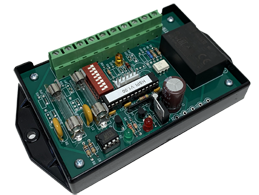
RTR-2C Ultra High-Speed Water & Gas Meter Relay
The RTR-2C Ultra High-Speed Repeating Pulse Relay using a high-speed digital signal processor to interface high-speed pulses from water and gas meters to RTU’s, meters, counters or similar telemetry. The RTR-2C is configured with one Form A (2-wire) pulse input and two corresponding Form A (KY) isolated, solid-state dry contact pulse outputs. Most water and gas meters with standard pulse outputs are directly compatible to the RTR-2C’s input, whether it is an open-collector transistor, open-drain FET, MOSFET solid state relay, or read relay. The input is activated when the input (Yin) is switched from its “pulled up” state, down to ground (Kin) for at least a minimum pulse debounce time. Eight input filter times are field-selectable: 25, 50, 100, 200 or 500 microseconds, or 1, 5 or 20 milliseconds. With the appropriate filtering time, noise that could be counted as pulses is ignored.
When the RTR-2C relay is inserted between the water or gas meter and the remote equipment, it provides two duplicated pulse outputs, providing pulses to two pieces of remote equipment while electrically isolating them so as to eliminate problems with noise or intermingling of circuits. The RTR-2C also provides an output terminal with 12V at 20mA for powering the water or gas meter if required.
Typical applications involve pulse counting, monitoring and recording of water or gas usage. Other applications include interfaces between utility metering devices and customer-owned building automation systems, control and monitoring systems, usage recorders, automated meter reading systems and supervisory control and data acquisition systems (SCADA). Bright yellow LED lamp, on the RTR-2C’s input indicates the input’s status at all times, thus allowing the field technician to visually observe pulses being received from the water or gas meter. A bright green LED visually shows the outputs’ status. No specialized test equipment is required. The microcontroller-based RTR-2C checks each incoming pulse for its duration. If the incoming pulse is less than the input filter time selected, the RTR-2C assumes the incoming pulse to be noise and it is rejected. Thus, any valid pulse rate of 200 pulses per second or less is accepted while static and induced high frequency noise is rejected. If used in a very noisy environment this “pulse acceptance window” may be lengthened or shortened as needed to reject noise by selecting a different input filter time. The RTR-2C also includes a test mode with diagnostics to determine if very, very short pulses are received.
The RTR-2C has two modes on the output operation: normal and fixed. The normal mode’s outputs follows the input so the duty cycle on the output is a mirror image of the input and timing is the same. In the fixed mode, an output closure time is selected and the output closes for a fixed time period. The RTR-2C has selectable output closure times of 5, 10, 20, 50, 100, 200, 500 or 1000 milliseconds, regardless of the input pulse’s duration. The output duration time is easily selected on the RTR-2C’s DIP switch. In this way, pulses can either be “stretched” or shortened to suit the receiving equipment. In the event that the input pulse rate exceeds the output time such that input pulses are arriving from the meter faster than the output can handle, the microcontroller stores up to 65,565 pulses and outputs them in a 50/50 duty cycle as soon as possible so that no pulses are lost. If more than 65,565 pulses are stored, then the RED LED lights indicating a count register overflow condition.
The RTR-2C therefore provides a contact closure of sufficient and fixed length to the remote equipment & allows the revenue water or gas meter display to operate normally. The input and output terminal strip is a “Euro” type connector for easy field wiring and excellent isolation. The “K” leads of the RTR-2C’s outputs are fused to prevent damage to the relay under almost any conditions a user might cause such as excessive current, incorrect wiring, etc. RTR-2C models have built-in transient protection for the solid-state relay’s contacts that eliminates the need for external or off-the-board transient suppressors.Specifications
| Electrical | |
|---|---|
| Power Input: | 90-130, 208 to 277 VAC. Burden: <10 mA at 120 VAC |
| Pulse Inputs: | Two Form A (KY) pulse inputs with a +8 to +13VDC wetting voltage. Current source inputs provide for fixed current through meter contact. |
| Pulse Output: | Two sets of dry Form A (KY) contacts. Outputs are activated (closed) for a nominal 5,10,20, 50, 100, 200, 500mS, or 1000mS following a valid input pulse as selected. The contacts are solid state “no bounce” relays rated at 120 VAC/VDC @ 1/10 Amp. The maximum rating of the contacts is 800mW. Factory fused at 1/10 amp. (3AG or AGC) |
| Contact On-State Resistance: | 25 ohms maximum, 18 typical |
| Operate and Release Time: | Turn On: 5 mS maximum, 2-3 mS typical
Turn Off: 5 mS maximum, 2-3 mS typical |
| Input/Output Isolation Voltage: | 2500Vrms |
| Mechanical | |
|---|---|
| Mounting: | Any position |
| Size: | 3.27” wide, 5.65” high, 1.50” deep |
| Weight: | 13 ounces |
| Temperature | |
|---|---|
| Temperature Range: | -38º C to +70º C, -38.4º F to +158º F |
| Humidity: | 0 to 98% non-condensing |
| Available Options | |
|---|---|
| Input Voltages: | 125 VDC input using the DSC-1 Power Supply. |
| Input Configurations: | Sourced Voltage inputs are available which receive a voltage from +3 to +48VDC from external systems. |
All specifications are subject to change without notice.
